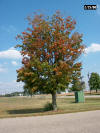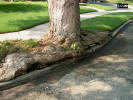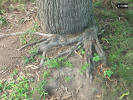|
 |
|
|
|
 |
|
Large,
established trees may begin to deteriorate over a period
of years for no apparent reason. Trees most commonly
affected include oaks, ash, sugar and Norway maples.
 When no specific disease, insect or cultural problem can
be determined as the cause, the tree is said to be "in
decline." Generally, a tree declines because it is under
stress. Symptoms develop slowly and may be so subtle
that most people don't notice them until the problem is
in advanced stages. When no specific disease, insect or cultural problem can
be determined as the cause, the tree is said to be "in
decline." Generally, a tree declines because it is under
stress. Symptoms develop slowly and may be so subtle
that most people don't notice them until the problem is
in advanced stages.
Keys symptoms of decline include:
-
fewer leaves develop on the tree
-
leaves are smaller than normal in
size
-
early leaf drop in late summer
-
premature fall color
-
tips of branches die back
-
small branches die
-
leaf scorch (browning on the edges)
-
trees becomes more susceptible to
other insect and disease problems
|
|
 |
|
What Causes Decline?
Decline is not the result of a specific
insect or disease. It is the buildup of several stresses that combine to
weaken a tree.
Generally, trees decline because they can no
longer move enough water from the roots to support the leaves. Or, for some
reason, they are not able to manufacture enough energy in the leaves to
sustain the tree through the winter.
|
|
 |
The most common cause of decline in large
trees is a change in the root zone of the tree including:
 Restriction: As the tree grows, it
needs more room. The roots of most trees are concentrated in the top 18 to 24
inches of soil and extend out past the "drip line" of the canopy.
Large trees often out grow their space and can no longer support their canopy
without help. Sidewalks, driveways, streets, structures, sewers, etc. all tend
to restrict root zones. Restriction: As the tree grows, it
needs more room. The roots of most trees are concentrated in the top 18 to 24
inches of soil and extend out past the "drip line" of the canopy.
Large trees often out grow their space and can no longer support their canopy
without help. Sidewalks, driveways, streets, structures, sewers, etc. all tend
to restrict root zones.
Soil Compaction: Construction
activities, vehicle traffic or just foot traffic tend to compact
soils. Water
cannot penetrate and low oxygen levels may kill roots.* Excavation: Any
digging near trees damage their roots. Trenching, laying foundations, sewer
repair, underground utilities, etc. all can cause problems.
Drought or Floods: Too little water
causes roots to die back. Some large trees may never be able to reestablish
roots lost in a drought. Wet sites where water stands may cause root rot.
Soil Fertility
: In
extreme cases, low soil fertility or incorrect
pH may contribute to decline.
|
|
 |
Trunk Problems
Vessels in the trunks of trees transport
water up to the leaves or carbohydrates down to the roots. Factors that may
lead to damage to these vessels include:
Trunk Wounding: Damage by lawnmowers,
weed whips, etc. can cause wounds in tree trunks.
 Girdling: If the
cambium layer
located just beneath the bark is damaged, the tree will be unable to grow in
girth. Minor damage will interfere with the movement of carbohydrates to the
roots. Major damage of the cambium will kill the tree. Some trees, especially
Norway maples, develop roots which circle around the trunk just below ground
level. As the tree grows, these roots restrict the cambium layer and may
result in decline and death. Girdling: If the
cambium layer
located just beneath the bark is damaged, the tree will be unable to grow in
girth. Minor damage will interfere with the movement of carbohydrates to the
roots. Major damage of the cambium will kill the tree. Some trees, especially
Norway maples, develop roots which circle around the trunk just below ground
level. As the tree grows, these roots restrict the cambium layer and may
result in decline and death.
|
|
 |
|
Diagnosing Shade Tree Decline
Determining the cause of decline
may be difficult since it is not the result of a single attack by an
insect or disease. Key factors to consider include:
-
Time: Decline is a gradual
process that normally occurs over years as individual stresses multiply.
-
Symptoms: The key symptom of
decline is not what is present but what is missing. Fewer leaves,
smaller leaves, dead branches and a general "unhealthy"
appearance usually indicate decline.
Leaf spot diseases,
insect damage
and other symptoms may be secondary or may indicate that the problem is
something other than decline.
|
|
 |
|
Dealing With Decline
The sooner the treatment
begins, the better the chances of survival. Unfortunately, most cases of
decline are not noticed until advanced stages of the disorder. After
several years of decline, trees may be so weak that nothing will save
them. The key is to eliminate or minimize the conditions that are
stressing the tree.
Plant the Right Tree: When
planting new trees, choose the right tree for the site. Avoid planting
large trees such as
sugar,
Norway and
silver maples, and
sycamore
in small, restricted sites.
Deep Root Watering: In
compacted soils, water applied to the surface may not penetrate deep
enough to help the tree. Special attachments are available for garden
hoses which will deliver water into the root zone of most trees.
Aerating and vertical mulching discussed below will also help with water
penetration.
 Fertilize: Periodically
fertilize trees using tree spikes or other methods for placing
fertilizers 12 to 18 inches into the root zone of the tree. Fertilize: Periodically
fertilize trees using tree spikes or other methods for placing
fertilizers 12 to 18 inches into the root zone of the tree.
Aerate the Root Zone: Drill or
drive holes into the soil 18 inches deep in many places beneath the
canopy to allow water penetration.
Vertical Mulching: Using a post
hole digger, make several holes 18 inches deep under the canopy of the
tree. Fill the bottom 12 inches of the hole with a porous material such
as woodchips, gravel or coarse sand. Replace the last few inches of top
soil and the sod plug on top. This allows moisture and nutrients to
penetrate to a depth to be useful to the trees.
|
|



